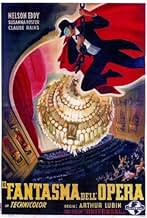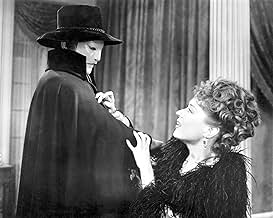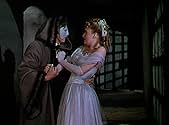CALIFICACIÓN DE IMDb
6.4/10
8.9 k
TU CALIFICACIÓN
Un compositor con cicatrices de ácido sale de las cloacas de París para impulsar la carrera de su suplente de ópera favorita.Un compositor con cicatrices de ácido sale de las cloacas de París para impulsar la carrera de su suplente de ópera favorita.Un compositor con cicatrices de ácido sale de las cloacas de París para impulsar la carrera de su suplente de ópera favorita.
- Dirección
- Guionistas
- Elenco
- Ganó 2 premios Óscar
- 3 premios ganados y 5 nominaciones en total
Kate Drain Lawson
- Landlady
- (as Kate Lawson)
Opiniones destacadas
I'm not sure if I'd call this a horror movie(it's certainly a drama).It is the result of good acting,filming,and glorious color!!!!!!!I've never seen a Universal horror movie in color other than this!The story isn't a real adaption of Gaston Leroux's novel.It has several changes made that make it different from the book.It's a must-see for movie lovers.Horror or otherwise.
The Phantom Of The Opera is a 1943 adaptation of the classic novel of the same name, directed by Arthur Lubin and starring Claude Rains, Susanna Foster and Nelson Eddy.
I think I'm not alone when I say that the best part of this film is the gorgeous and colorful cinematography and beautiful sets and costumes which make this a visually outstanding film however aside from this I think it is very forgettable.
The acting is OK and that's really it, even Claude Rains, one of the greatest actors of all time isn't particularly memourable in this film. I'm also not the biggest fan of the movie's tone, it just feels too light hearted and almost goofy, ruining most of the suspense, at least for me.
6.8/10
Gaston Leroux's penny-dreadful novel was hardly the stuff of great literature, but it did manage to tap into the public consciousness with its gas-light-Gothic tale of a beautiful singer menaced by a horrific yet seductive serial killer lurking in the forgotten basement labyrinths of the Paris Opera. Lon Chaney's silent classic kept the basic elements of the novel intact--and proved one of the great box office hits of its day, a fact that prompted Universal Studios to contemplate a remake throughout most of the 1930s.
Although several proposals were considered (including one intended to feature Deanna Durbin, who despised the idea and derailed the project with a flat refusal), it wasn't until 1943 that a remake reached the screen. And when it did, it was an eye-popping Technicolor extravaganza, all talking, all singing, and dancing. The Phantom had gone musical.
In many respects this version of PHANTOM anticipates the popular Andrew Lloyd Webber stage musical, for whereas the Chaney version presented the Phantom as a truly sinister entity, this adaptation presents the character as one more sinned against than sinning--an idea that would color almost every later adaptation, and Webber's most particularly so. But it also shifts the focus of the story away from the title character, who is here really more of a supporting character than anything else. The focus is on Paris Opera star Christine Dae, played by Susanna Foster. In this version Christine is not only adored by the Phantom; she is also romantically pursued by two suitors who put aside their differences to protect her.
Directed by Universal workhorse Arthur Lubin, this version is truly eye-popping as only a 1940s Technicolor spectacular could be: the color is intensely brilliant, and Lubin makes the most of it by focusing most of his camera-time on the stage of the Paris Opera itself and splashing one operatic performance after another throughout the film. But in terms of actual story interest, the film is only so-so. Susanna Foster had a great singing voice, but she did not have a memorable screen presence, and while the supporting cast (which includes Nelson Eddy, Edgar Barrier, Leo Carrillo, and Jane Farrar) is solid enough they lack excitement. And the pace of the film often seems a bit slow, sometimes to the point of clunkiness.
The saving grace of the film--in addition to the aforementioned photography, which won an Oscar--is Claude Rains. A great artist, Rains did not make the mistake of copying Chaney, and although the script robs the Phantom of his most fearsome aspects, Rains fills the role with subtle menace that is wonderful to behold, completely transcending the film's slow pace, the lackluster script, and "sanitized for your protection" tone so typical of Universal Studios in the 1940s. Unless you're a die-hard Phantom fan you're likely to be unimpressed.
Gary F. Taylor, aka GFT, Amazon Reviewer
Although several proposals were considered (including one intended to feature Deanna Durbin, who despised the idea and derailed the project with a flat refusal), it wasn't until 1943 that a remake reached the screen. And when it did, it was an eye-popping Technicolor extravaganza, all talking, all singing, and dancing. The Phantom had gone musical.
In many respects this version of PHANTOM anticipates the popular Andrew Lloyd Webber stage musical, for whereas the Chaney version presented the Phantom as a truly sinister entity, this adaptation presents the character as one more sinned against than sinning--an idea that would color almost every later adaptation, and Webber's most particularly so. But it also shifts the focus of the story away from the title character, who is here really more of a supporting character than anything else. The focus is on Paris Opera star Christine Dae, played by Susanna Foster. In this version Christine is not only adored by the Phantom; she is also romantically pursued by two suitors who put aside their differences to protect her.
Directed by Universal workhorse Arthur Lubin, this version is truly eye-popping as only a 1940s Technicolor spectacular could be: the color is intensely brilliant, and Lubin makes the most of it by focusing most of his camera-time on the stage of the Paris Opera itself and splashing one operatic performance after another throughout the film. But in terms of actual story interest, the film is only so-so. Susanna Foster had a great singing voice, but she did not have a memorable screen presence, and while the supporting cast (which includes Nelson Eddy, Edgar Barrier, Leo Carrillo, and Jane Farrar) is solid enough they lack excitement. And the pace of the film often seems a bit slow, sometimes to the point of clunkiness.
The saving grace of the film--in addition to the aforementioned photography, which won an Oscar--is Claude Rains. A great artist, Rains did not make the mistake of copying Chaney, and although the script robs the Phantom of his most fearsome aspects, Rains fills the role with subtle menace that is wonderful to behold, completely transcending the film's slow pace, the lackluster script, and "sanitized for your protection" tone so typical of Universal Studios in the 1940s. Unless you're a die-hard Phantom fan you're likely to be unimpressed.
Gary F. Taylor, aka GFT, Amazon Reviewer
Poor old Enrique Claudin doesn't have much luck – and what he does have is all bad. An adept but unremarkable violinist with the Paris Opera House, he secretly worships Christine Dubois, the young understudy to the snooty leading songstress, and even goes so far as to anonymously spend all his money on singing lessons for her even though she is barely conscious of his existence. Enrique loses his job when he starts losing the feeling in his fingers. Then he mistakenly believes the musical manuscript he has been working on has been stolen by no less a light than Franz Liszt (Lord only knows how he wandered into this). Gripped by a violent rage, Enrique throttles the bad-tempered music publisher who prevents him from retrieving his manuscript and ends up with a face full of acid courtesy of the publisher's panicky secretary. Evading capture by the police, Enrique hides in the sewers beneath the Opera House and, like a tomato that's rolled under the cooker, grows dark and warped in the darkness.
Gaston Laroux's Phantom of the Opera is one of those stories that filmmakers feel compelled to retell every couple of years, so there's not a great deal to set this apart from all those other versions. Universal's use of colour is uncharacteristically sumptuous, and given that this tale falls nominally into the horror category for which they were famed, it stands by comparison to their other output of the time as something of a prestige production. There's not really much horror to speak of – although, by modern standards, none of the 40s horror films are likely to scare anyone over the age of five, so it's not out of the ordinary there. In fact it would arguably be more accurate to describe it as a musical given the amount of time that's given over to opera numbers that do little other than pause the action.
Claude Rains gives a typically polished performance as the tormented Claudin, although the failure of the script to get under his character's (scorched) skin once he assumes the identity of the Phantom leaves the actor with little to work with once he dons the mask and descends into B-movie madness. Nobody else in the cast really stands out. Susanna Foster makes a rather unmemorable ingénue (who shows worrying indications of following the same path as the prima donna she replaces given the way some of their lines are nearly identical), and leaves you wondering why poor old Claudin got so hot and bothered over her in the first place. Nelson Eddy and Edgar Barrier provide some light relief as the troupe's baritone and the investigating police officer, both of whom also fall under Miss Foster's mysterious spell.
Phantom of the Opera provides a good example of 40s Hollywood expertise (although it looks more like an MGM film than a Universal), and is entertaining enough even though it rarely provides anything that's likely to stick in the mind. Arthur Lubin at least attempts moments of artistry – for example by having the camera repeatedly passing sources of light – candelabras, chandeliers, etc – to suggest the fatal fascination Claudin's object of unrequited love holds for him.
Gaston Laroux's Phantom of the Opera is one of those stories that filmmakers feel compelled to retell every couple of years, so there's not a great deal to set this apart from all those other versions. Universal's use of colour is uncharacteristically sumptuous, and given that this tale falls nominally into the horror category for which they were famed, it stands by comparison to their other output of the time as something of a prestige production. There's not really much horror to speak of – although, by modern standards, none of the 40s horror films are likely to scare anyone over the age of five, so it's not out of the ordinary there. In fact it would arguably be more accurate to describe it as a musical given the amount of time that's given over to opera numbers that do little other than pause the action.
Claude Rains gives a typically polished performance as the tormented Claudin, although the failure of the script to get under his character's (scorched) skin once he assumes the identity of the Phantom leaves the actor with little to work with once he dons the mask and descends into B-movie madness. Nobody else in the cast really stands out. Susanna Foster makes a rather unmemorable ingénue (who shows worrying indications of following the same path as the prima donna she replaces given the way some of their lines are nearly identical), and leaves you wondering why poor old Claudin got so hot and bothered over her in the first place. Nelson Eddy and Edgar Barrier provide some light relief as the troupe's baritone and the investigating police officer, both of whom also fall under Miss Foster's mysterious spell.
Phantom of the Opera provides a good example of 40s Hollywood expertise (although it looks more like an MGM film than a Universal), and is entertaining enough even though it rarely provides anything that's likely to stick in the mind. Arthur Lubin at least attempts moments of artistry – for example by having the camera repeatedly passing sources of light – candelabras, chandeliers, etc – to suggest the fatal fascination Claudin's object of unrequited love holds for him.
This 1943 version is a remake of the 1925 version from the same studio (Universal). Probably the most vivid and effective use of Technicolor I have seen. Lush photography, great crane shots and an impressive Paris Opera House! The operatic scenes are very well done--and they are important to the story line. Very entertaining, especially since there is no graphic violence or gore--except the Phantom's face. Nelson Eddy is in top voice. One of Hollywood's most versatile actors, Claude Rains is remarkable in the lead role. Just the year before he was the memorable Prefect of Police in "Casablanca." This production is mounted first class in every way.
The DVD release is a fantastic transfer from an original old Technicolor master.
The DVD release is a fantastic transfer from an original old Technicolor master.
¿Sabías que…?
- TriviaThe original script revealed Claudin to be Christine's father, who abandoned her and her mother in order to pursue a musical career. When this was excised from the final film, it left Claudin's obsession with Christine unexplained.
- ErroresWhen Christine takes the mask off from Phantom's face, we see that his scar reaches the low area of his right cheek, even the right eyelid is slightly fallen. But before that during the entire film, we never see a single mark of the scar on the uncovered area of the Phantom's face, not even the fallen eyelid through the mask.
- Citas
[Christine has left Raoul and Anatole in her dressing room while she greets a crowd of admirers]
Raoul D'Aubert: Would you join me for a bit of supper at the Cafe de l'Opera?
Anatole Garron: With pleasure, monsieur.
Raoul D'Aubert: Think we can get through this crowd?
Anatole Garron: Certainly. After all, who'd pay any attention to a baritone and a detective?
- ConexionesFeatured in Weirdo with Wadman: Phantom of the Opera (1964)
- Bandas sonorasLULLABY OF THE BELLS
(uncredited)
Written by Edward Ward
Lyrics George Waggner
Sung by Susanna Foster and Nelson Eddy
Selecciones populares
Inicia sesión para calificar y agrega a la lista de videos para obtener recomendaciones personalizadas
- How long is Phantom of the Opera?Con tecnología de Alexa
Detalles
- Fecha de lanzamiento
- País de origen
- Idioma
- También se conoce como
- Phantom of the Opera
- Locaciones de filmación
- Productora
- Ver más créditos de la compañía en IMDbPro
Taquilla
- Presupuesto
- USD 1,500,000 (estimado)
- Tiempo de ejecución1 hora 32 minutos
- Mezcla de sonido
- Relación de aspecto
- 1.37 : 1
Contribuir a esta página
Sugiere una edición o agrega el contenido que falta

Principales brechas de datos
By what name was El fantasma de la ópera (1943) officially released in India in English?
Responda





































